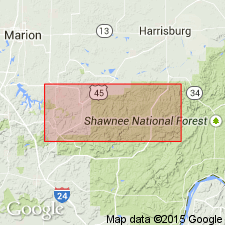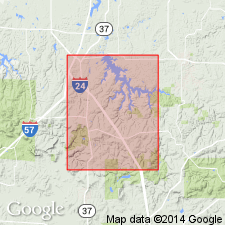
- Usage in publication:
-
- Cedar Creek sandstone lentil
- Modifications:
-
- First used
- Dominant lithology:
-
- Sandstone
- AAPG geologic province:
-
- Illinois basin
Summary:
A widespread but generally thin sandstone in the middle Abbott Formation is here informally named the Cedar Creek sandstone lentil. It can be traced through most of the area along and southeast of the New Burnside anticline in the Creal Springs quad. Unit is generally fine to medium-grained, light gray to buff when fresh, weathering to brown. Iron oxide is abundant. Planar cross-bedding evident where the sandstone is thick. Equivalent to the lower part of the olive shale to the east.
Source: GNU records (USGS DDS-6; Reston GNULEX).

- Usage in publication:
-
- Cedar Creek sandstone lentil
- Modifications:
-
- Revised
- AAPG geologic province:
-
- Illinois basin
Summary:
Cedar Creek sandstone lentil is reassigned from the Abbott Formation to the Tradewater Formation. Tradewater Formation in the Goreville quad. is subdivided into two informal mapping units, the lower Tradewater and the upper. These two units were mapped originally as the Abbott and Spoon Formations, but this earlier nomenclature was abandoned midway through the COGEOMAP project. The term Tradewater was adopted from KY and applied to this interval of rocks in IL as part of an agreement with the IN and KY Surveys to standardize Pennsylvanian terminology in the Illinois basin. Several Pennsylvanian informal members and sandstone lentils are used in this report. The top of the lower Tradewater is mapped as the top of the Murray Bluff Sandstone Member (a correlative of the Bernadotte Sandstone Member of Willman, 1975). The remainder of the lower Tradewater is subdivided into the ascending informal Ferne Clyffe member, Cedar Creek sandstone lentil, and Lake of Egypt member. The Reynoldsburg Coal Bed is found near the base of the Ferne Clyffe. The informal Bethlehem sandstone lentil occupies the approximate middle of the upper Tradewater.
Source: GNU records (USGS DDS-6; Reston GNULEX).
For more information, please contact Nancy Stamm, Geologic Names Committee Secretary.
Asterisk (*) indicates published by U.S. Geological Survey authors.
"No current usage" (†) implies that a name has been abandoned or has fallen into disuse. Former usage and, if known, replacement name given in parentheses ( ).
Slash (/) indicates name conflicts with nomenclatural guidelines (CSN, 1933; ACSN, 1961, 1970; NACSN, 1983, 2005, 2021). May be explained within brackets ([ ]).

